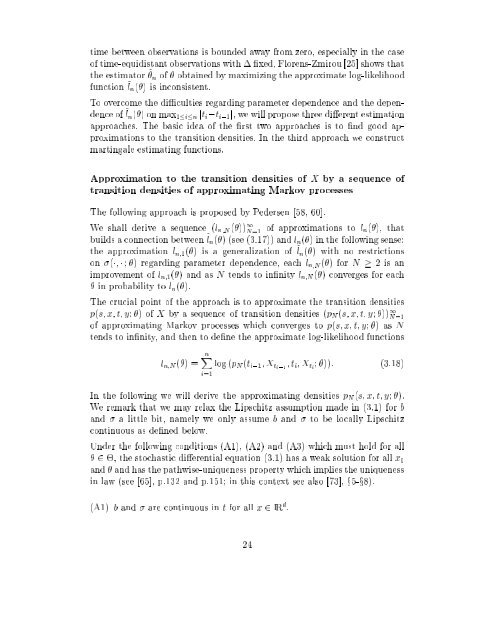Estimation in Financial Models - RiskLab
Estimation in Financial Models - RiskLab
Estimation in Financial Models - RiskLab
You also want an ePaper? Increase the reach of your titles
YUMPU automatically turns print PDFs into web optimized ePapers that Google loves.
time between observations is bounded away from zero, especially <strong>in</strong> the case<br />
of time-equidistant observations with xed, Florens-Zmirou [25] shows that<br />
the estimator ~ n of obta<strong>in</strong>ed by maximiz<strong>in</strong>g the approximate log-likelihood<br />
function ~ l n () is <strong>in</strong>consistent.<br />
To overcome the diculties regard<strong>in</strong>g parameter dependence and the dependence<br />
of ~ l n ()onmax 1<strong>in</strong> jt i ,t i,1 j,we will propose three dierent estimation<br />
approaches. The basic idea of the rst two approaches is to nd good approximations<br />
to the transition densities. In the third approach we construct<br />
mart<strong>in</strong>gale estimat<strong>in</strong>g functions.<br />
Approximation to the transition densities of X by a sequence of<br />
transition densities of approximat<strong>in</strong>g Markov processes<br />
The follow<strong>in</strong>g approach is proposed by Pedersen [58, 60].<br />
We shall derive a sequence (l n;N ()) 1 N=1<br />
of approximations to l n (), that<br />
builds a connection between ~ l n () (see (3.17)) and l n () <strong>in</strong> the follow<strong>in</strong>g sense:<br />
the approximation l n;1 () is a generalization of ~ l n () with no restrictions<br />
on (; ; ) regard<strong>in</strong>g parameter dependence, each l n;N () for N 2 is an<br />
improvement of l n;1 () and as N tends to <strong>in</strong>nity l n;N () converges for each<br />
<strong>in</strong> probability tol n ().<br />
The crucial po<strong>in</strong>t of the approach is to approximate the transition densities<br />
p(s; x; t; y; ) of X by a sequence of transition densities (p N (s; x; t; y; )) 1 N=1<br />
of approximat<strong>in</strong>g Markov processes which converges to p(s; x; t; y; ) as N<br />
tends to <strong>in</strong>nity, and then to dene the approximate log-likelihood functions<br />
l n;N () =<br />
nX<br />
i=1<br />
log (p N (t i,1 ;X ti,1 ;t i ;X ti ; )): (3.18)<br />
In the follow<strong>in</strong>g we will derive the approximat<strong>in</strong>g densities p N (s; x; t; y; ).<br />
We remark that we may relax the Lipschitz assumption made <strong>in</strong> (3.1) for b<br />
and a little bit, namely we only assume b and to be locally Lipschitz<br />
cont<strong>in</strong>uous as dened below.<br />
Under the follow<strong>in</strong>g conditions (A1), (A2) and (A3) which must hold for all<br />
2 , the stochastic dierential equation (3.1) has a weak solution for all x 0<br />
and and has the pathwise-uniqueness property which implies the uniqueness<br />
<strong>in</strong> law (see [65], p.132 and p.151; <strong>in</strong> this context see also [73], x5-x8).<br />
(A1) b and are cont<strong>in</strong>uous <strong>in</strong> t for all x 2 IR d .<br />
24
















